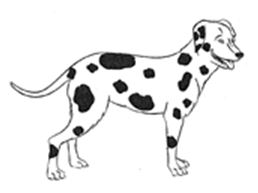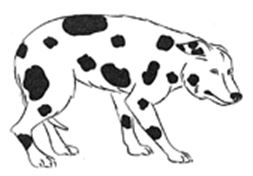Dog safety
Stay up-to-date: join us on Facebook
External linkInner West Pets Facebook
Have you visited Pet Town?
Did you know the NSW Government has developed an interactive educational tool to help children in grades K-2 learn about dog safety and responsible pet ownership?
Head over to the Pet Town website to work through the activities online, or download the app.
Dog behaviour and body language
Many dogs are friendly but, at times, some may feel angry, frightened or excited. It is important we understand a dog's needs and feelings so that we (and our pets!) can stay safe and happy.
When approached by a strange dog, it is important to look carefully at the dog's behaviour and body language.
Friendly dogs appear relaxed and calm.

Frightened dogs appear unfriendly and may bite.
They have their tail lowered and sometimes between their legs. They may stand crouched down or cowering and may have their head lowered and turned away and not look at you.

Angry dogs are unfriendly and may bite.
An angry dog will stand up straight, have its ears up, straighten its tail and may lift its lip or bark.

Children and dogs
DOGGY DOs
- Practise identifying a dog's body language
- Wait to see if the dog comes to you and wants to be patted
- Curl your fingers and slowly hold your hand out for the dog to sniff
- Ask the adult with you if it's OK to pat the dog
- Ask the dog owner if it's OK for you to pat the dog
- Ask the dog also!
- Practise safe interaction with friendly dogs
- Practise how to manage an angry or frightened dog
- Learn how to approach a friendly dog
- Stand quietly next to the dog (not in front as this may scare him or her)
- Pat the dog under the chin or on the front of the chest
DOGGY DON'Ts
- Approaching an unknown dog or one acting strangely
- Jumping around or screaming
- Teasing or playing rough
- Staring at the dog
- Patting the top of the dog's head
- Disturbing a dog that is eating or sleeping
- Running towards or around an unknown dog
- Trying to pat a dog who is backing away or running away from you
- Cuddling a dog around its face
Remember: just because your own pet dog may be friendly and tolerant does not mean all dogs will be!
Children should never be left alone with any dog, even the family pet dog. Be aware that a dog's tolerance level – even the family pet dog – may change when it gets older, is in pain or stressed, or when it has been overexposed to children and just wants to be left alone.
What to do if approached by a strange dog
- Don't run – stand completely still
- Don't pat the dog
- Don't talk to the dog or try to calm it down
- Tuck your hands under your arms
- Do not look into the dog's eyes
- Stay calm – don't scream
- Slowly back away
- If a dog jumps on you or knocks you over, don't scream – remain quiet, curl up into a ball, put your head down and tuck your arms and hands under your chest until the dog goes away. Screaming, moving around or pushing the dog away may make the dog angry or increase its excitement or anxiety.